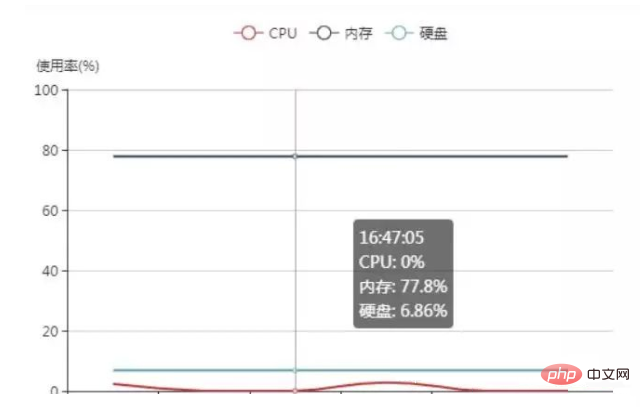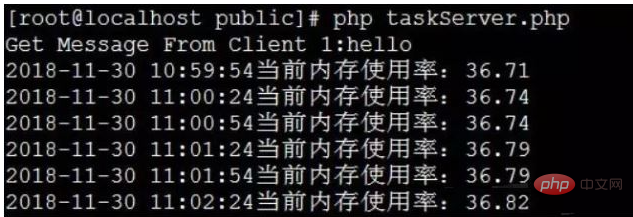 Backend Development
Backend Development
 PHP Tutorial
PHP Tutorial
 php Swoole implements millisecond scheduled tasks (detailed explanation)
php Swoole implements millisecond scheduled tasks (detailed explanation)
php Swoole implements millisecond scheduled tasks (detailed explanation)
项目开发中,如果有定时任务的业务要求,我们会使用linux的crontab来解决,但是它的最小粒度是分钟级别,如果要求粒度是秒级别的,甚至毫秒级别的,crontab就无法满足,值得庆幸的是swoole提供的强大的毫秒定时器。【推荐:PHP视频教程】
应用场景举例
我们可能会遇到这样的场景:
场景一:每隔30秒获取一次本机内存使用率
场景二:2分钟后执行报表发送任务
场景三:每天凌晨2点钟定时请求第三方接口,如果接口有数据返回则停止任务,如果接口由于某种原因没有响应或者没有数据返回则5分钟后继续尝试请求该接口,尝试5次后仍然失败则停止该任务
以上的三个场景我们都可以归纳为定时任务的范畴。
Swoole毫秒定时器
Swoole提供了异步毫秒定时器函数:
swoole_timer_tick(int $msec, callable $callback):设置一个间隔时钟定时器,每隔$msec毫秒执行一次$callback,类似于javascript中的setInterval()。
swoole_timer_after(int $after_time_ms, mixed $callback_function):在指定的时间$after_time_ms后执行$callback_function,类似于javascript的setTimeout()。
swoole_timer_clear(int $timer_id):删除指定id的定时器,类似于javascript的clearInterval()。
解决方案
对于场景一,经常用在系统检测统计方面,实时性要求比较高,但又能控制好频率,多用于后台服务器性能监控,可以生成可视化图表。可以是30秒获取一次内存使用率,也可以是10秒,而crontab最小粒度只能设置为1分钟。
swoole_timer_tick(30000, function($timer) use ($task_id) { // 启用定时器,每30秒执行一次
$memPercent = $this->getMemoryUsage(); //计算内存使用率
echo date('Y-m-d H:i:s') . '当前内存使用率:'.$memPercent."\n";
});对于场景二,直接定义xx时间后执行某项任务的话,貌似crontab比较困难,而使用swoole的swoole_timer_after可以实现:
swoole_timer_after(120000, function() use ($str) { //2分钟后执行
$this->sendReport(); //发送报表
echo "send report, $str\n";
});对于场景三,用来作尝试请求,请求失败后继续,如果成功则停止请求。用crontab也能解决,但是比较傻,比如设置每隔5分钟请求一次,不管成功会失败都会去执行一次。而用swoole定时器则智能多了。
swoole_timer_tick(5*60*1000, function($timer) use ($url) { // 启用定时器,每5分钟执行一次
$rs = $this->postUrl($url);
if ($rs) {
//业务代码...
swoole_timer_clear($timer); // 停止定时器
echo date('Y-m-d H:i:s'). "请求接口任务执行成功\n";
} else {
echo date('Y-m-d H:i:s'). "请求接口失败,5分钟后再次尝试\n";
}
});示例代码
新建文件\src\App\Task.php:
namespace Helloweba\Swoole;
use swoole_server;
/**
* 任务调度
*/
class Task
{
protected $serv;
protected $host = '127.0.0.1';
protected $port = 9506;
// 进程名称
protected $taskName = 'swooleTask';
// PID路径
protected $pidPath = '/run/swooletask.pid';
// 设置运行时参数
protected $options = [
'worker_num' => 4, //worker进程数,一般设置为CPU数的1-4倍
'daemonize' => true, //启用守护进程
'log_file' => '/data/log/swoole-task.log', //指定swoole错误日志文件
'log_level' => 0, //日志级别 范围是0-5,0-DEBUG,1-TRACE,2-INFO,3-NOTICE,4-WARNING,5-ERROR
'dispatch_mode' => 1, //数据包分发策略,1-轮询模式
'task_worker_num' => 4, //task进程的数量
'task_ipc_mode' => 3, //使用消息队列通信,并设置为争抢模式
];
public function __construct($options = [])
{
date_default_timezone_set('PRC');
// 构建Server对象,监听127.0.0.1:9506端口
$this->serv = new swoole_server($this->host, $this->port);
if (!empty($options)) {
$this->options = array_merge($this->options, $options);
}
$this->serv->set($this->options);
// 注册事件
$this->serv->on('Start', [$this, 'onStart']);
$this->serv->on('Connect', [$this, 'onConnect']);
$this->serv->on('Receive', [$this, 'onReceive']);
$this->serv->on('Task', [$this, 'onTask']);
$this->serv->on('Finish', [$this, 'onFinish']);
$this->serv->on('Close', [$this, 'onClose']);
}
public function start()
{
// Run worker
$this->serv->start();
}
public function onStart($serv)
{
// 设置进程名
cli_set_process_title($this->taskName);
//记录进程id,脚本实现自动重启
$pid = "{$serv->master_pid}\\n{$serv->manager_pid}";
file_put_contents($this->pidPath, $pid);
}
//监听连接进入事件
public function onConnect($serv, $fd, $from_id)
{
$serv->send( $fd, "Hello {$fd}!" );
}
// 监听数据接收事件
public function onReceive(swoole_server $serv, $fd, $from_id, $data)
{
echo "Get Message From Client {$fd}:{$data}\n";
//$this->writeLog('接收客户端参数:'.$fd .'-'.$data);
$res['result'] = 'success';
$serv->send($fd, json_encode($res)); // 同步返回消息给客户端
$serv->task($data); // 执行异步任务
}
/**
* @param $serv swoole_server swoole_server对象
* @param $task_id int 任务id
* @param $from\id int 投递任务的worker_id
* @param $data string 投递的数据
*/
public function onTask(swoole_server $serv, $task_id, $from_id, $data)
{
swoole_timer_tick(30000, function($timer) use ($task_id) { // 启用定时器,每30秒执行一次
$memPercent = $this->getMemoryUsage();
echo date('Y-m-d H:i:s') . '当前内存使用率:'.$memPercent."\n";
});
}
/**
* @param $serv swoole_server swoole_server对象
* @param $task_id int 任务id
* @param $data string 任务返回的数据
*/
public function onFinish(swoole_server $serv, $task_id, $data)
{
//
}
// 监听连接关闭事件
public function onClose($serv, $fd, $from_id) {
echo "Client {$fd} close connection\n";
}
public function stop()
{
$this->serv->stop();
}
private function getMemoryUsage()
{
// MEMORY
if (false === ($str = @file("/proc/meminfo"))) return false;
$str = implode("", $str);
preg_match_all("/MemTotal\s{0,}\:+\s{0,}([\d\.]+).+?MemFree\s{0,}\:+\s{0,}([\d\.]+).+?Cached\s{0,}\:+\s{0,}([\d\.]+).+?SwapTotal\s{0,}\:+\s{0,}([\d\.]+).+?SwapFree\s{0,}\:+\s{0,}([\d\.]+)/s", $str, $buf);
//preg_match_all("/Buffers\s{0,}\:+\s{0,}([\d\.]+)/s", $str, $buffers);
$memTotal = round($buf[1][0]/1024, 2);
$memFree = round($buf[2][0]/1024, 2);
$memUsed = $memTotal - $memFree;
$memPercent = (floatval($memTotal)!=0) ? round($memUsed/$memTotal*100,2):0;
return $memPercent;
}
}我们以场景一为例,在onTask启用定时任务,每隔30秒计算一次内存使用率。实际应用中可以把计算好的内存按时间写入数据库等存储中,然后可以根据前端需求用来渲染成统计图表,如:

接着服务端代码 public\taskServer.php :
<?php require dirname(__DIR__) . '/vendor/autoload.php'; use Helloweba\Swoole\Task; $opt = [ 'daemonize' => false ]; $ser = new Task($opt); $ser->start();
客户端代码 public\taskClient.php :
<?php
class Client
{
private $client;
public function __construct() {
$this->client = new swoole_client(SWOOLE_SOCK_TCP);
}
public function connect() {
if( !$this->client->connect("127.0.0.1", 9506 , 1) ) {
echo "Error: {$this->client->errMsg}[{$this->client->errCode}]\n";
}
fwrite(STDOUT, "请输入消息 Please input msg:");
$msg = trim(fgets(STDIN));
$this->client->send( $msg );
$message = $this->client->recv();
echo "Get Message From Server:{$message}\n";
}
}
$client = new Client();
$client->connect();验证效果
1.启动服务端:
php taskServer.php
2.客户端输入:
另开命令行窗口,执行
[root@localhost public]# php taskClient.php
请输入消息 Please input msg:hello
Get Message From Server:{"result":"success"}
[root@localhost public]#3.服务端返回:

如果返回上图中的结果,则定时任务正常运行,我们会发现每隔30秒会输出一条信息。
The above is the detailed content of php Swoole implements millisecond scheduled tasks (detailed explanation). For more information, please follow other related articles on the PHP Chinese website!

Hot AI Tools

Undresser.AI Undress
AI-powered app for creating realistic nude photos

AI Clothes Remover
Online AI tool for removing clothes from photos.

Undress AI Tool
Undress images for free

Clothoff.io
AI clothes remover

Video Face Swap
Swap faces in any video effortlessly with our completely free AI face swap tool!

Hot Article

Hot Tools

Notepad++7.3.1
Easy-to-use and free code editor

SublimeText3 Chinese version
Chinese version, very easy to use

Zend Studio 13.0.1
Powerful PHP integrated development environment

Dreamweaver CS6
Visual web development tools

SublimeText3 Mac version
God-level code editing software (SublimeText3)

Hot Topics
 PHP 8.4 Installation and Upgrade guide for Ubuntu and Debian
Dec 24, 2024 pm 04:42 PM
PHP 8.4 Installation and Upgrade guide for Ubuntu and Debian
Dec 24, 2024 pm 04:42 PM
PHP 8.4 brings several new features, security improvements, and performance improvements with healthy amounts of feature deprecations and removals. This guide explains how to install PHP 8.4 or upgrade to PHP 8.4 on Ubuntu, Debian, or their derivati
 7 PHP Functions I Regret I Didn't Know Before
Nov 13, 2024 am 09:42 AM
7 PHP Functions I Regret I Didn't Know Before
Nov 13, 2024 am 09:42 AM
If you are an experienced PHP developer, you might have the feeling that you’ve been there and done that already.You have developed a significant number of applications, debugged millions of lines of code, and tweaked a bunch of scripts to achieve op
 How To Set Up Visual Studio Code (VS Code) for PHP Development
Dec 20, 2024 am 11:31 AM
How To Set Up Visual Studio Code (VS Code) for PHP Development
Dec 20, 2024 am 11:31 AM
Visual Studio Code, also known as VS Code, is a free source code editor — or integrated development environment (IDE) — available for all major operating systems. With a large collection of extensions for many programming languages, VS Code can be c
 Explain JSON Web Tokens (JWT) and their use case in PHP APIs.
Apr 05, 2025 am 12:04 AM
Explain JSON Web Tokens (JWT) and their use case in PHP APIs.
Apr 05, 2025 am 12:04 AM
JWT is an open standard based on JSON, used to securely transmit information between parties, mainly for identity authentication and information exchange. 1. JWT consists of three parts: Header, Payload and Signature. 2. The working principle of JWT includes three steps: generating JWT, verifying JWT and parsing Payload. 3. When using JWT for authentication in PHP, JWT can be generated and verified, and user role and permission information can be included in advanced usage. 4. Common errors include signature verification failure, token expiration, and payload oversized. Debugging skills include using debugging tools and logging. 5. Performance optimization and best practices include using appropriate signature algorithms, setting validity periods reasonably,
 How do you parse and process HTML/XML in PHP?
Feb 07, 2025 am 11:57 AM
How do you parse and process HTML/XML in PHP?
Feb 07, 2025 am 11:57 AM
This tutorial demonstrates how to efficiently process XML documents using PHP. XML (eXtensible Markup Language) is a versatile text-based markup language designed for both human readability and machine parsing. It's commonly used for data storage an
 PHP Program to Count Vowels in a String
Feb 07, 2025 pm 12:12 PM
PHP Program to Count Vowels in a String
Feb 07, 2025 pm 12:12 PM
A string is a sequence of characters, including letters, numbers, and symbols. This tutorial will learn how to calculate the number of vowels in a given string in PHP using different methods. The vowels in English are a, e, i, o, u, and they can be uppercase or lowercase. What is a vowel? Vowels are alphabetic characters that represent a specific pronunciation. There are five vowels in English, including uppercase and lowercase: a, e, i, o, u Example 1 Input: String = "Tutorialspoint" Output: 6 explain The vowels in the string "Tutorialspoint" are u, o, i, a, o, i. There are 6 yuan in total
 Explain late static binding in PHP (static::).
Apr 03, 2025 am 12:04 AM
Explain late static binding in PHP (static::).
Apr 03, 2025 am 12:04 AM
Static binding (static::) implements late static binding (LSB) in PHP, allowing calling classes to be referenced in static contexts rather than defining classes. 1) The parsing process is performed at runtime, 2) Look up the call class in the inheritance relationship, 3) It may bring performance overhead.
 What are PHP magic methods (__construct, __destruct, __call, __get, __set, etc.) and provide use cases?
Apr 03, 2025 am 12:03 AM
What are PHP magic methods (__construct, __destruct, __call, __get, __set, etc.) and provide use cases?
Apr 03, 2025 am 12:03 AM
What are the magic methods of PHP? PHP's magic methods include: 1.\_\_construct, used to initialize objects; 2.\_\_destruct, used to clean up resources; 3.\_\_call, handle non-existent method calls; 4.\_\_get, implement dynamic attribute access; 5.\_\_set, implement dynamic attribute settings. These methods are automatically called in certain situations, improving code flexibility and efficiency.





